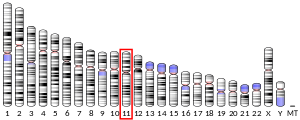LRTOMT
| LRTOMT | |||||||||||||||||||||||||||||||||||||||||||||||||||
|---|---|---|---|---|---|---|---|---|---|---|---|---|---|---|---|---|---|---|---|---|---|---|---|---|---|---|---|---|---|---|---|---|---|---|---|---|---|---|---|---|---|---|---|---|---|---|---|---|---|---|---|
| Identifiers | |||||||||||||||||||||||||||||||||||||||||||||||||||
| Aliases | LRTOMT, CFAP111, DFNB63, LRRC51, leucine rich transmembrane and O-methyltransferase domain containing, TOMT, LRRC51-TOMT | ||||||||||||||||||||||||||||||||||||||||||||||||||
| External IDs | OMIM: 612414; MGI: 3769724; HomoloGene: 19664; GeneCards: LRTOMT; OMA:LRTOMT - orthologs | ||||||||||||||||||||||||||||||||||||||||||||||||||
| |||||||||||||||||||||||||||||||||||||||||||||||||||
| |||||||||||||||||||||||||||||||||||||||||||||||||||
| |||||||||||||||||||||||||||||||||||||||||||||||||||
| |||||||||||||||||||||||||||||||||||||||||||||||||||
| |||||||||||||||||||||||||||||||||||||||||||||||||||
| Wikidata | |||||||||||||||||||||||||||||||||||||||||||||||||||
| |||||||||||||||||||||||||||||||||||||||||||||||||||
Transmembrane O-methyltransferase (TOMT) is a protein encoded by the LRTOMT gene in humans. Located on chromosome 11, mutations in LRTOMT are associated with the DFNB63 form of autosomal recessive nonsyndromic hearing loss.
Function
[edit]LRTOMT is a fusion between the LRRC51 and TOMT genes in humans. The fusion gene contains 10 exons that encode two separate proteins translated from unique and overlapping open reading frames (ORFs). Translation of LRTOMT1, a protein that contains leucine-rich repeats, starts in exon 3 and stops at exon 6. Translation of LRTOMT2, also known as TOMT or COMT2, starts in exon 5 and ends at exon 10. Human TOMT has a predicted methyltransferase domain that is conserved with catechol-o-methyltransferase (COMT) and a single predicted transmembrane alpha helix. Mice and zebrafish have separate genes for Lrrc51 and Tomt.[5]
TOMT is required for cochlear hair cell function and is associated with components of the mechanoelectrical transduction (MET) channel, including TMC1. While the mechanism by which TOMT contributes to MET currents and auditory function is currently unknown, the methyltransferase domain is likely not involved. Mutations in TOMT disrupt the stereocilia localization of MET channel subunits and are thus thought to affect MET currents. These results have also been illustrated in multiple mutations in both mice and zebrafish.[6][7]
Clinical significance
[edit]Over 20 variants in TOMT have been shown to cause hearing loss in humans. Populations reported to be most affected by TOMT-related hearing loss include Iranian and Tunisian families.[8]
| Variant | Identified Population |
|---|---|
| Leu16Pro | Iranian |
| Ala29Ser (frameshift) | Turkish |
| Thr33His (frameshift) | American |
| Met34Ilu | Iranian |
| Pro36Leu (frameshift) | Iranian |
| Ser45Ser (frameshift) | Iranian |
| Glu40Asp | Iranian |
| Arg41Trp | Iranian |
| Arg52Trp | Pakistani |
| Arg54Gln | Japanese |
| Leu60Pro | Mauritanian |
| Trp65Arg | Tunisian |
| Arg70X | Iranian |
| Tyr71X | Iranian |
| Glu80Asp | Iranian |
| Arg81Gln | Tunisian |
| Phe83Leu | Czech |
| Trp105Arg | Tunisian |
| Glu110Lys | Tunisian |
| Tyr111X | Iranian |
| Arg158His | Chinese |
| Ala170Ala (frameshift) | Iranian |
| Ilu188Thr (frameshift) | Japanese |
| Arg219X | Chinese |
While most variations cause prelingual profound sensorineural deafness, one patient with compound heterozygous mutations (Arg52Trp and Arg54Gln) was reported to develop ski-slope hearing loss starting at age 11.[9]
TOMT has also been associated with postmenopausal osteoporosis in rats. Specifically, LRTOMT downregulation after ovariectomy was significantly correlated with decreased bone density and changes in bone microstructure.[10]
References
[edit]- ^ a b c GRCh38: Ensembl release 89: ENSG00000284922 – Ensembl, May 2017
- ^ a b c GRCm38: Ensembl release 89: ENSMUSG00000078630 – Ensembl, May 2017
- ^ "Human PubMed Reference:". National Center for Biotechnology Information, U.S. National Library of Medicine.
- ^ "Mouse PubMed Reference:". National Center for Biotechnology Information, U.S. National Library of Medicine.
- ^ Ahmed, Zubair (2008). "Mutations of LRTOMT, a fusion gene with alternative reading frames, cause nonsyndromic deafness in humans". Nat Genet. 40 (11): 1335–1340. doi:10.1038/ng.245. PMC 3404732. PMID 18953341.
- ^ Cunningham, Christopher. "The murine catecholamine methyltransferase mTOMT is essential for mechanotransduction by cochlear hair cells". eLife.
- ^ Erickson, Timothy. "Integration of Tmc1/2 into the mechanotransduction complex in zebrafish hair cells is regulated by Transmembrane O-methyltransferase (Tomt)". eLife.
- ^ Sarmadi, Akram (2020). "A novel pathogenic variant in the LRTOMT gene causes autosomal recessive non-syndromic hearing loss in an Iranian family". BMC Medical Genetics. 21 (1): 127. doi:10.1186/s12881-020-01061-7. PMC 7285524. PMID 32517708.
- ^ Kim, Yehree (2022). "Molecular aetiology of ski-slope hearing loss and audiological course of cochlear implantees". Eur Arch Otorhinolaryngol. 279 (10): 4871–4882. doi:10.1007/s00405-022-07317-7. PMID 35212774.
- ^ Yang, Yong-Jie (2023). "Postmenopausal osteoporosis: Effect of moderate-intensity treadmill exercise on bone proteomics in ovariectomized rats". Front Surg. 9. doi:10.3389/fsurg.2022.1000464. PMC 9852312. PMID 36684175.
Further reading
[edit]Charif, Majida (2012). "The c.242G>A mutation in LRTOMT gene is responsible for a high prevalence of deafness in the Moroccan population". Mol Biol Rep. 39 (12): 11011–11016. doi:10.1007/s11033-012-2003-3. PMID 23053991.
Gibriel, Abdullah (2019). "Analysis of p.Gly12Valfs*2, p.Trp24* and p.Trp77Arg mutations in GJB2 and p.Arg81Gln variant in LRTOMT among non syndromic hearing loss Egyptian patients: implications for genetic diagnosis". Mol Biol Rep. 46 (2): 2139–2145. doi:10.1007/s11033-019-04667-0. PMID 30730013.
Ichinose, Aya (2015). "Novel mutations in LRTOMT associated with moderate progressive hearing loss in autosomal recessive inheritance". Ann Otol Rhinol Laryngol. 124 Suppl 1: 142S–7S. doi:10.1177/0003489415575043. PMID 25788562.
Mosrati, Mohamed (2021). "Deep analysis of the LRTOMTc.242G>A variant in non-syndromic hearing loss North African patients and the Berber population: Implications for genetic diagnosis and genealogical studies". Mol Genet Genomic Med. 9 (10): e1810. doi:10.1002/mgg3.1810. PMC 8580077. PMID 34514748.
Salame, Malak (2023). "Identification a novel pathogenic LRTOMT mutation in Mauritanian families with nonsyndromic deafness". Eur Arch Otorhinolaryngol. 280 (9): 4057–4063. doi:10.1007/s00405-023-07907-z. PMID 36928321.
Schulze, JM (2009). "LRTOMT: a new tone in understanding the symphony of non-syndromic deafness". Clin Genet. 75 (3): 227–229. doi:10.1111/j.1399-0004.2009.01150_3.x. PMID 19250379.
Vanwesemael, Maarten (2011). "A 1 bp deletion in the dual reading frame deafness gene LRTOMT causes a frameshift from the first into the second reading frame". Am J Med Genet A. 155A (8): 2021–2023. doi:10.1002/ajmg.a.34096. PMID 21739586.




